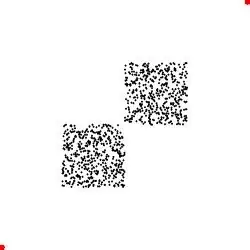The result of an observation of a function $\,f(x,y,z)\,$
with Gaussian blur $\,G(x,y,z)\,$ for example is
in general a convolution integral: $$ \overline{f} =
\iiint G(\xi,\eta,\zeta)\,f(x-\xi,y-\eta,z-\zeta)\,d\xi\,d\eta\,d\zeta $$
Here $\,G\,$ is the kernel function of the blur and $\,f\,$ is the function to be
observed. The function $\,f\,$ is developed into a Taylor series around
$\,(\xi,\eta,\zeta)=(0,0,0)$ :
$$ f(x-\xi,y-\eta,z-\zeta) \; \approx \; f(x,y,z) $$
$$ - \xi \frac{\partial f}{\partial x} - \eta \frac{\partial f}{\partial y} - \zeta \frac{\partial f}{\partial z} $$
$$ + \frac{1}{2} \xi^2 \frac{\partial^2 f}{\partial x^2} + \frac{1}{2} \eta^2 \frac{\partial^2 f}{\partial y^2}
+ \frac{1}{2} \zeta^2 \frac{\partial^2 f}{\partial z^2} $$
$$ + \xi \eta \frac{\partial f}{\partial x \partial y} + \eta \zeta \frac{\partial f}{\partial y \partial z}
+ \zeta \xi \frac{\partial f}{\partial z \partial x} $$
In this expression the partial differential quotients are no longer dependent
on $\,(\xi,\eta,\zeta)$ , because they are calculated for
$\,(\xi,\eta,\zeta)=(0,0,0)$ . Therefore the convolution integral is approximately
equal to:
$$ f(x,y,z) \iiint \, G \, d\xi\,d\eta\,d\zeta \\ \, - \, \frac{\partial f}{\partial x}
\iiint \xi \, G \, d\xi\,d\eta\,d\zeta \, - \, \frac{\partial f}{\partial y}
\iiint \eta \, G \, d\xi\,d\eta\,d\zeta \, - \, \frac{\partial f}{\partial z}
\iiint \zeta \, G \, d\xi\,d\eta\,d\zeta \\
+ \frac{1}{2} \frac{\partial^2 f}{\partial x^2}\iiint \xi^2 \, G \, d\xi\,d\eta\,\zeta
+ \frac{1}{2} \frac{\partial^2 f}{\partial y^2}\iiint \eta^2 \, G \, d\xi\,d\eta\,d\zeta
+ \frac{1}{2} \frac{\partial^2 f}{\partial z^2}\iiint \zeta^2\, G \, d\xi\,d\eta\,d\zeta \\
+ \frac{\partial f}{\partial x \partial y}\iiint \xi \eta \, G \, d\xi\,d\eta\,d\zeta
+ \frac{\partial f}{\partial y \partial z}\iiint \eta \zeta \, G \, d\xi\,d\eta\,d\zeta
+ \frac{\partial g}{\partial z \partial x}\iiint \zeta \xi \, G \, d\xi\,d\eta\,d\zeta
$$
The first integral is by definition equal to $\,1$ . The next three integrals are
equal to the expectation value of the Gaussian kernel function, and therefore equal
to $\,0$ . The next three integrals are equal to the spreads of the Gaussian kernel function
in the different coordinate directions. The last three integrals, at last, are
zero. Thus: $$ \overline{f} \approx
f + \frac{1}{2} \sigma_x^2 \frac{\partial^2 f}{\partial x^2} + \frac{1}{2} \sigma_y^2 \frac{\partial^2 f}{\partial y^2}
+ \frac{1}{2} \sigma_z^2 \frac{\partial^2 f}{\partial z^2} = f + \frac{1}{2} \sigma^2 \nabla^2 f $$
An asymptotic approximation for large distances, which can also be found
in any decent book about Statistics, where the last equality is for the
isotropic case only.
One possible application is the
renormalization
of singularities, for example the Electric field
of a point charge:
$$
E(r) = \frac{q}{4\pi\epsilon_0 r^2} \quad \mbox{with} \quad
\begin{cases} q = \mbox{(point) charge} \\ \epsilon_0 = \mbox{dielectric constant} \\ r = \mbox{distance to point} \end{cases}
$$
The far away field can be calculated without even knowing about the convolution integral:
$$
\overline{E} \approx E + \frac{1}{2} \sigma^2 \nabla^2 E \qquad \mbox{with} \qquad
\nabla^2 \frac{1}{r^2} =
\frac{1}{r} \frac{\partial^2}{\partial r^2} r \frac{1}{r^2} = \frac{2}{r^4}
$$
Hence:
$$
\overline{E} \approx E \left( 1 + \frac{\sigma^2}{r^2} \right) \quad \mbox{for} \quad r \gg \sigma
$$
The Electric field with Gaussian blur is:
$$
\overline{E}(x,y,z) = \left( \frac{1}{ \sigma \sqrt{2\pi} } \right)^3
\iiint \frac{q}{4 \pi \epsilon_0 ( \xi^2 + \eta^2 + \zeta^2 ) } \,
e^{\, - [ (\xi - x)^2 + (\eta - y)^2 + (\zeta - z)^2 ] / 2\sigma^2 }
\; d\xi\,d\eta\,d\zeta
$$
A special case is the value of the renormalized field at the origin, which turns out to be nicely finite :
$$
\overline{E}(r=0) = \left( \frac{1}{ \sigma \sqrt{2\pi} } \right)^3 \frac{q}{\epsilon_0}
\int_0^\infty e^{- r^2 / 2 \sigma^2 } d r =
\left( \frac{1}{ \sigma \sqrt{2\pi} } \right)^3 \frac{q}{\epsilon_0}
\frac{1}{2} \sigma \sqrt{2\pi} = \frac{q}{4 \pi \epsilon_0 \sigma^2 }
= E(\sigma)
$$
Anything in between is somewhat more difficult ..
